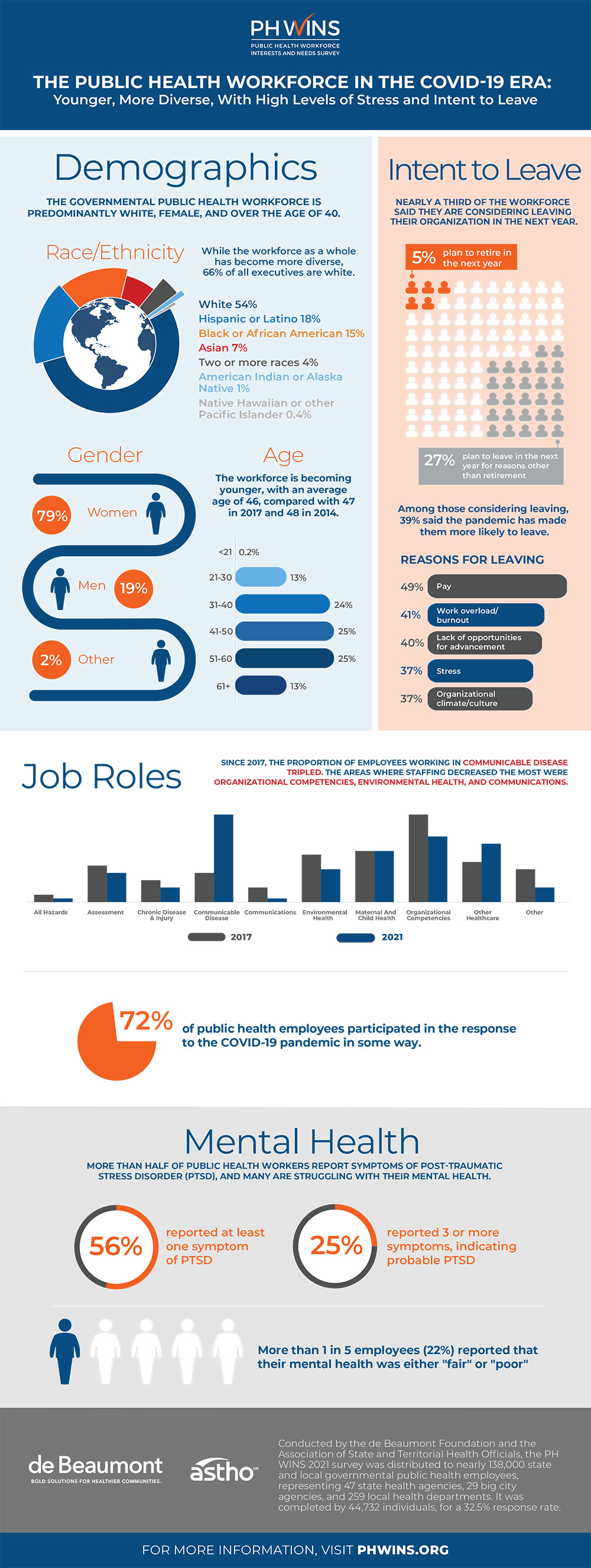The 2021 Public Health Workforce Interests and Needs Survey (PH WINS) was conducted by the de Beaumont Foundation and the Association of State and Territorial Health Officials (ASTHO) between September 2021 and January 2022. The survey provides data on workforce demographics, job characteristics, training needs, intent to stay or leave, professional engagement and satisfaction, and other areas. Previously conducted in 2014 and 2017, PH WINS is the only nationally representative survey of state and local government public health employees in the United States.
Interactive data dashboards, released in August 2022
Explore survey findings on stress and burnout, released March 2022
Key Findings
- Demographics: Most public health workers self-identify as white (54%), as women (79%), and as age 40 or older (63%). While the workforce has become more diverse and now mirrors the U.S. population more closely, there is much less diversity at senior levels, with 66% of all executives identifying as white. Access the Demographics dashboard.
- Job roles: Nearly three in four public health employees (72%) participated in the response to the COVID-19 pandemic in some way. Relative to 2017, the proportion of employees working in communicable disease increased three-fold, rising from 8% to 24%, and the portion working in nearly all other job categories decreased. Among the areas where staffing decreased the most were organizational competencies, environmental health, and communications, which decreased from 24% to 18%, 13% to 9%, and 4% to 1%, respectively.
- Intent to leave: Nearly one-third of state and local public health employees (32%) said they are considering leaving their organization in the next year – 5% to retire and 27% for another reason. Among those who said they’re considering leaving, 39% said the pandemic has made them more likely to leave. Looking out further, 44% said they are considering leaving within the next five years. Access the Staying & Leaving dashboard.
- Training needs: Across seniority levels, budgeting and financial management are top areas of high day-to-day importance but low proficiency among public health professionals. More than in previous surveys, policy engagement and topics related to justice, equity, diversity, and inclusion were identified as important areas of needed training, especially by senior staff and executives. Access the Training Needs dashboard.
- Stress and burnout: Initial survey findings released in March 2022 revealed high levels of stress, burnout, and intent to leave among the governmental public health workforce during the COVID-19 pandemic. Explore these findings.
Publications
Madsen ER, Schaffer K, Hare Bork R, Yeager VA. “On-the-Job Learning: Bright spots of governmental public health employee reflections on the COVID-19 response,” Journal of Public Health Management and Practice. March 2024.
Madsen ER, Schaffer K, Hare Bork R, Yeager VA. “Teamwork and Collaboration: Bright spots of governmental public health employee reflections on the COVID-19 response,” Journal of Public Health Management and Practice. March 2024.
Madsen ER, Schaffer K, Hare Bork R, Yeager VA. “Leadership: Bright spots of governmental public health employee reflections on the COVID-19 response,” Journal of Public Health Management and Practice. March 2024.
Leider JP, Castrucci BC, Robins M, Hare Bork R, Fraser MR, Savoia E, Piltch-Loeb R, Koh HK. “The Exodus of State and Local Public Health Employees: Separations Started Before and Continued Throughout COVID-19,” Health Affairs. March 2023.
Special Supplement: PH WINS 2021. Journal of Public Health Management and Practice. January 2023; epub November 30, 2022. A collection of timely and practical editorials, commentaries, and recommendations that will help public health leaders make research-based decisions to strengthen their organization.
Hare Bork R, Robins M, Schaffer K, Leider JP, Castrucci BC. “Perceptions and Experience in the Workplace Related to COVID-19 Response Efforts among Public Health Workers – United States, September 2021–January 2022,” Morbidity and Mortality Weekly Report, Centers for Disease Control and Prevention, July 21, 2022.
Summary reports
Download a summary report of the national-level data or explore the findings by setting or HHS region.
Overall
Setting
States | Big Cities | Other Locals
HHS Region
Regions 1 & 2 | Region 3 | Region 4 | Region 5 | Region 6 | Region 7 & 8 | Region 9 | Region 10
Workforce Groups
Chronic Disease | Community Health Workers | Emergency Preparedness | Environmental Health | Epi/Surveillance | Health Educators | Immunizations | Influenza | Injury/Substance Misuse | Lab Professionals | Maternal & Child Health | Nurses | STIs, HIV, Hepatitis, & TB
Methodology
The PH WINS survey was distributed to 137,447 state and local governmental public health workers, representing 47 state health agencies, 29 big-city health departments, 159 medium (serving a population between 25,000 and 250,000) and large local health departments (serving a population of more than 250,000), and, for the first time, 100 small local health departments. (“Big-city health departments” refers specifically to the members of the Big Cities Health Coalition, composed of lead health officials from 29 of the largest U.S. cities. Responses from these big-city departments are not included in the figures for “other medium to large local health departments.”) The survey was completed by 44,732 individuals, for a 32.5% response rate.
Through a partnership between the Region V Public Health Training Center and Northwest Center for Public Health Practice, PH WINS was able to include small local health departments in the Midwest and Pacific Northwest with a staff size of fewer than 25 or serving populations of fewer than 25,000. Approximately 2,000 of 3,000 small local health department employees completed the survey.
View the survey instrument and additional information.
Submit a Data Use Request.
To request data from PH WINS 2021, please fill out this short form.

